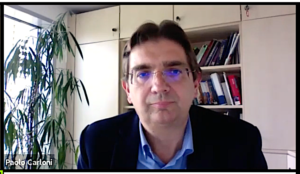 Original
Original  HERE
HERE
.
 .
.
.
Paolo Carloni
..The binding of protons and their transport through the cell membrane are crucial steps for many cellular processes. CLC chloride/proton transporters are present in almost every living cell and regulate the pH value, chloride concentrations and membrane potentials of intracellular cell compartments.
Various human diseases, which are caused by dysfunctional CLC transporters and which range from osteopetrosis and kidney dysfunction to epilepsy and mental retardation, illustrate the high physiological and pharmacological impact of this class of membrane proteins.
.
CLC transporters transport a large number of anions, but are inhibited by fluoride, the smallest anion in the periodic table. Scientists from the Institute of Neurosciences and Medicine (Computational Biomedicine) and the Institute of Biological Information Processing (Molecular and Cellular Physiology) at Forschungszentrum Jülich have used massively parallel hybrid quantum mechanical/classical mechanical simulations to investigate how these chloride transporters differentiate between the anions and what happens when fluoride binds to the protein. In a process that can be described only at the quantum mechanical level, fluoride simultaneously binds protons and an amino acid side chain, which usually shuttles protons across the membrane. This locks the CLC transporter in a fixed position and inhibits the transport process.
.
This theoretical study was made possible by an interface between MM and QM codes developed by a European network including Paolo Carloni’s team at the Institute of Neurosciences and Medicine. The interface is currently boosting a variety of quantum mechanical modelling studies of biological systems in Forschungszentrum Jülich and worldwide.
.
Original publication:
Molecular Basis of CLC Antiporter Inhibition by Fluoride,
Maria Gabriella Chiariello, Viacheslav Bolnykh, Emiliano Ippoliti,
Simone Meloni, Jógvan Magnus Haugaard Olsen, Thomas Beck,
Ursula Rothlisberger, Christoph Fahlke, Paolo Carloni
Journal of the American Chemical Society 2020 142 (16), 7254-7258,
DOI: 10.1021/jacs.9b13588
‘
Further Information:
Institute for Advanced Simulation,
Computational Biomedicine (IAS-5 / INM-9)
.
Molecular Basis of CLC Antiporter Inhibition by Fluoride
…CLC channels and transporters conduct or transport
various kinds of anions, with the exception of fluoride,
which acts as an effective inhibitor…

 MORE
MORE 
.
See details 
Supporting Information
Including 20+ diagrams
.
Reproduced by:






